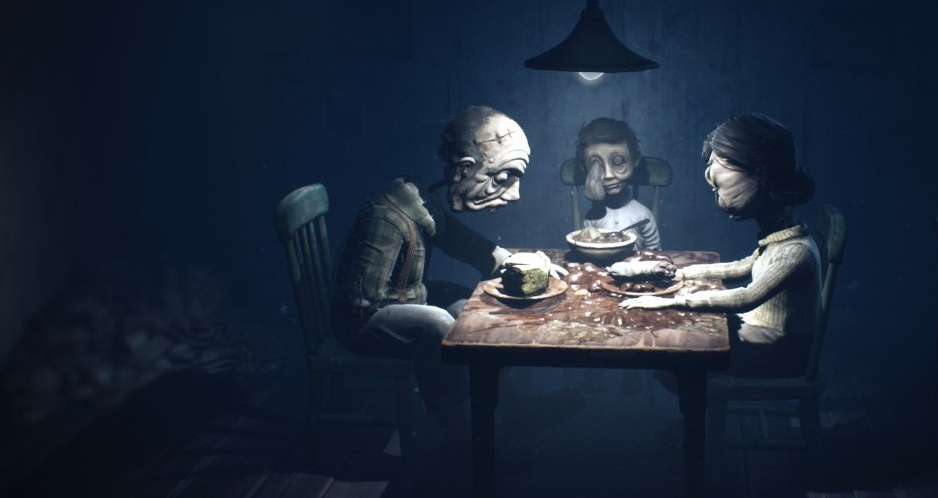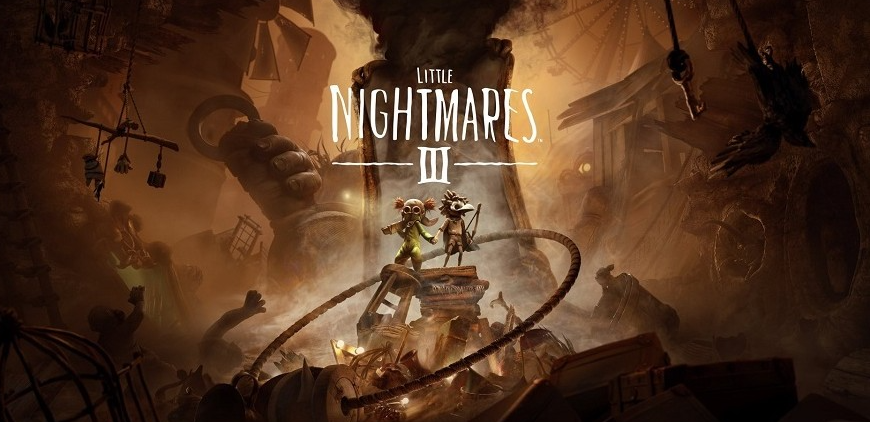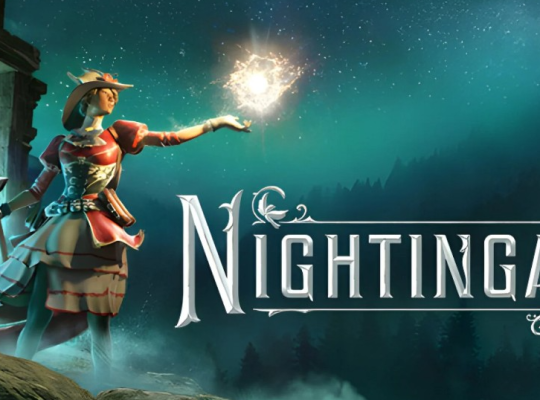Little Nightmares III belongs to a specific gaming sub-genre, akin to its predecessors and contemporaries like Inside and Limbo, games that bear the signature style of studios such as Playdead. This genre seamlessly weaves together elements of platforming, puzzle-solving, and horror, often featuring vulnerable protagonists, typically children, thrust into nightmarish scenarios.
While this sub-genre lacks a formal title, the descriptor “Child Murder Simulator” has been playfully suggested, capturing the unsettling essence that characterizes these games. Despite its provocative nature, the term highlights the genre’s focus on placing young characters in perilous situations, a distinctive element that sets these games apart.
Little Nightmares III: A Chilling Descent into Childhood Nightmares
In the vast landscape of video games, where intricate systems and elaborate mechanics often dominate, there exists a unique space carved out by titles like Little Nightmares III. This game defies conventional norms, presenting players with an experience that is both haunting and awe-inspiring. It stands as a testament to the distinct allure of video games, showcasing an essence that transcends other forms of media, especially in the realm of horror.
For those familiar with the inaugural Little Nightmares installment, the third iteration promises a continuation of the eerie and atmospheric journey. For newcomers, Little Nightmares III serves as a gruesome yet enthralling introduction to a world where the line between childhood fears and adult nightmares blurs. The masterminds behind this unnerving odyssey are the developers at Tarsier Studios, a collective determined to evoke childhood traumas in even the most seasoned players.
Little Nightmares III beckons players into a realm where conventional gaming norms take a backseat. The absence of expected systems, attributes, and mechanics creates a void filled with an unsettling purity. It is within this void that the true essence of video games as an art form flourishes, offering an experience that eludes replication in other media. The horror embedded in the game mirrors the genre itself—both deserving of serious consideration from the broader critical community.
As with its predecessors, Little Nightmares III melds platforming, puzzle-solving, and horror into a seamless tapestry. The game’s spine-chilling narrative unfolds as players guide a small, vulnerable protagonist through a series of nightmarish challenges. The journey into madness is orchestrated by Tarsier Studios, a development team unyielding in its commitment to instill fear and discomfort, even in the minds of grown-ass adults.
What sets Little Nightmares III apart is its ability to elicit a range of emotions, from enthrallment to nervous anticipation. The game’s visual and auditory elements work in tandem to create an immersive experience, plunging players into a world where darkness is both a friend and a foe. The atmospheric design and meticulously crafted environments contribute to the overall sense of dread, ensuring that every step forward is laden with apprehension.
Little Nightmares III stands as a testament to the unique capabilities of video games as an art form. Its departure from traditional gaming norms, coupled with its unapologetic focus on horror and vulnerability, cements its place in a sub-genre that defies easy classification.
Tarsier Studios’ commitment to pushing the boundaries of fear and imagination reinforces the notion that video games, much like the horror genre itself, should be acknowledged and appreciated by a broader critical audience. Little Nightmares III, with its enthralling narrative and nerve-racking gameplay, beckons players to confront the darkness within and emerge changed, haunted by the echoes of childhood nightmares.
Little Nightmares III: A Chilling Awakening in a Twisted Netherworld
Embark on a journey into the unsettling depths of horror with Little Nightmares III, the latest creation from Tarsier Studios. In this third-person puzzle stealth horror game, players assume the role of Six, a barefoot girl draped in a raincoat reminiscent of Georgie from Stephen King’s IT. Six’s quest revolves around escaping The Maw, a colossal underwater vessel teeming with oversized malevolence, all eager to consume her once alerted to her presence.
Little Nightmares III unfolds as a whimsical, twisted netherworld populated by grotesque childhood monster archetypes. Despite the narrative revealing scant details about Six’s background, players find themselves sharing in her terror as she confronts elemental evils within the eerie confines of The Maw. The story manifests as an abridged fable, with the diminutive heroine emerging from obscurity to confront and evade horrors whose malevolence is palpable, and comprehensible in a fleeting glimpse as much as through prolonged observation.
The canvas of Little Nightmares III, much like its predecessors, is marked by conspicuous blank spaces. Despite the absence of a clear and coherent story, complex mechanics, or multi-dimensional characters, the game manages to weave a complete and resonant adventure within its relatively short three-to-four-hour runtime. The narrative resonates with the primal fears of childhood, tapping into the garish and smothering dread of imagined movements in the dark and the ominous potential shadows held when observed alone.

From a tall man with a twisted grin and long limbs to a lunchroom cook whose sheer size poses an unspoken threat, the game unapologetically thrusts monstrosities into the open, challenging players not to draw their attention. The fear of meeting the eyes of a stranger behind a mask, the paralyzing apprehension that follows, and the ghastly ramifications of accidental deaths inflicted upon Six create an immersive and chilling experience.
Little Nightmares III captures the essence of horror not through subtlety but by boldly presenting its terrors. The game dares players to navigate a world where monstrosities lurk openly, and the consequences of attracting their attention are swift and gruesome. Every accidental misstep, every inadvertent gaze that draws the eye of a malevolent force, elicits a cringe from players, enhancing the immersive horror experience.
Within the initial twenty minutes of playing Little Nightmares III, the allure and acclaim surrounding the game become palpable. The hype is justified, and the countless accolades bestowed upon the title are well-earned. While individual components might be subject to critical scrutiny when examined in isolation, the convergence of these elements results in nothing short of a masterpiece. Little Nightmares III stands as a testament to the power of atmospheric storytelling, invoking childhood fears and delivering an unforgettable, chilling adventure that lingers long after the game concludes.
Little Nightmares III: Navigating the Labyrinth of Dream Logic
Step into the mesmerizing world of Little Nightmares III, where gameplay nuances and meticulous puzzle design unveil a captivating experience. As players traverse this nightmarish realm as Six, the barefoot protagonist, it becomes evident that the developers at Tarsier Studios have intricately contemplated every aspect of their creation.
The level design in Little Nightmares III stands out as a testament to the developers’ creativity. The environments, though surreal and reminiscent of an Alice in Wonderland-esque hellhole, exude a sense of believability. Every item is meticulously placed, and passageways feel like practical components of the fantastical setting.
It’s as if Six is navigating through a nightmarish 20th-century Disney environment, where malevolent giants live, work, and sleep, rather than merely traversing setpiece environs designed to challenge intruders. The attention to detail and intentionality in puzzle placement adds layers of depth to the immersive experience.
A distinctive feature of Little Nightmares III is the living, breathing nature of the monsters that pursue Six. These adversaries are not mere obstacles but are designed with personalities that impact gameplay. In a memorable instance, a murderous chef momentarily abandoned the pursuit to pocket a wedge of cheese. This not only provided a brief respite for the player but also revealed a dimension to the monstrosity beyond its primary role as a relentless pursuer. Such moments of nuance and creativity are scattered throughout the game, contributing to its overall charm.
The journey through Little Nightmares III is a remarkably smooth ride, with the occasional bumps encountered early on as players acclimate to the intricacies of the world. Navigating dark and cluttered environments inherently involves moments of falling in love with non-critical paths, and attempting to reach inaccessible goals. While these instances may lead to Six meeting a brutal end, they add a layer of challenge without significantly tarnishing the overall experience. Frustrations are fleeting, and as the player’s eye for the world develops, the initial challenges become surmountable.
The initial struggle dissipates by the second hour, as players decipher most puzzles correctly and relish the experience. Little Nightmares III thrives on the concept of dream logic, where the seemingly irrational and surreal elements coalesce into a cohesive and engaging narrative. More often than not, instances of puzzle difficulty are a result of overthinking, emphasizing the importance of adapting to the dreamlike logic governing the game’s challenges.
In essence, Little Nightmares III invites players into a world where nightmares and dream logic intertwine. The meticulous design, nuanced gameplay, and memorable encounters with living monsters contribute to an experience that transcends the boundaries of conventional horror games. Tarsier Studios’ thoughtful approach to puzzle design and the incorporation of dream logic elevates Little Nightmares III into a realm where every discovery and challenge is a testament to the developers’ dedication to creating a truly captivating and immersive gaming experience.
Little Nightmares III: Navigating the Quirks of the Autosave System
In the eerie corridors of Little Nightmares III, a notable concern surfaces in the form of its autosave system. While the game excels in various aspects, the reliability of checkpoints becomes a potential stumbling block. Players often find themselves at the mercy of a dice toss when it comes to checkpoints, risking the frustration of logging in to discover they’ve regressed five or ten minutes from their last position. This issue becomes particularly irksome after a strenuous bout of running or completing a challenging puzzle.

The autosave indicator, though seemingly active, is not always a reliable marker of progress. It may record the acquisition of collectibles or other in-game achievements, but this does not necessarily translate to the ability to quit the game and seamlessly resume from that point. The potential setbacks associated with the autosave system can sting, catching players off guard and testing their patience. For those seeking a convenient quitting point, it’s advisable to do so at the clear conclusion of a chapter to mitigate the risk of losing progress.
As of the time of this writing, Little Nightmares III stands as a five-year-old game with a sequel, a title that has garnered considerable acclaim. If you find yourself here and have not yet experienced the haunting world of Little Nightmares III, a strong encouragement echoes to pick it up and immerse yourself in its chilling narrative.
Despite its age, the game retains its value, offering an experience that transcends mere gameplay hours. The developers behind this masterpiece deserve commendation for crafting an unforgettable journey that lingers in the player’s memory long after the completion of the game.
The quirkiness of the autosave system, while a point of contention, should not deter potential players from exploring the atmospheric depths of Little Nightmares III. The immersive horror experience, coupled with the meticulous level of design and creative nuances, makes it a worthwhile investment.
As with any game, it has its imperfections, and the autosave issue may require a level of adaptability from players. However, the overall impact of Little Nightmares III, its ability to evoke lasting emotions and leave an indelible mark, surpasses these minor setbacks.
In supporting the developers, players contribute to recognizing a work of art that extends beyond the gaming realm. Little Nightmares III, like its predecessor, exemplifies the hallmark of great horror — an experience that resonates in the mind long after the controller is set aside. Despite the quirks in its autosave system, the game stands as a testament to the developers’ dedication to delivering a truly memorable and impactful gaming experience.
Little Nightmares III: A Deep Dive into the Chilling Gameplay Experience
Venturing into the unsettling world of Little Nightmares III, players are met with a gaming experience that transcends conventional norms, offering a journey through atmospheric horror and intricate puzzles. As the third installment in this acclaimed series, Little Nightmares III builds upon the foundation laid by its predecessors, delivering a gameplay experience that is both haunting and enthralling.
At its core, Little Nightmares III is a third-person puzzle stealth horror game developed by Tarsier Studios. Players once again step into the small, barefoot shoes of Six, the protagonist, who navigates a nightmarish realm known as The Maw. This massive underwater vessel serves as the backdrop for the unfolding horrors, as oversized malevolent entities threaten to consume Six at the slightest hint of her presence.
One of the standout features of the game is its nuanced gameplay, where moments of discovery reveal the meticulous intentionality of the developers. The puzzles, intricately woven into the fabric of the narrative, showcase a level of creativity that keeps players engaged throughout. The level design contributes to the believability of the nightmarish setting, resembling an Alice in Wonderland-type hellhole where every environment feels like a practical part of the fantasy.
Six’s journey through this macabre world can be likened to navigating a nightmarish 20th-century Disney environment. The monsters that relentlessly pursue her are not mere obstacles; they are living entities designed with actual personalities that impact gameplay. This attention to detail adds depth to the horror, making every encounter with these monstrosities a chilling and memorable experience.
Little Nightmares III masterfully incorporates dream logic into its gameplay, where seemingly irrational elements coalesce to form a cohesive and engaging narrative. The game challenges players to adapt to this dreamlike logic, presenting puzzles that require more intuition than conventional problem-solving. Moments of revelation and understanding become integral components of the gameplay, creating an immersive experience that goes beyond mere mechanical interactions.
While the journey through Little Nightmares III is generally smooth, the autosave system emerges as a potential point of contention. Checkpoints become a dice toss, occasionally setting players back by a few minutes and potentially leading to frustration, especially after completing challenging puzzles or evading pursuing monsters.
The autosave indicator, while active in recording progress, does not always guarantee a seamless pick-up from the last recorded point. Despite this quirk, the overall impact of the gameplay, enriched by the game’s atmospheric design and creative puzzles, overshadows these minor setbacks.
As a five-year-old game with a sequel, Little Nightmares III continues to captivate players with its timeless appeal. The recommendation to experience this chilling adventure remains strong, as the game’s ability to evoke lasting emotions and leave a profound imprint on the player’s memory extends far beyond its completion.
Supporting the developers becomes a commendable act, acknowledging their dedication to creating a truly memorable and impactful gaming experience with Little Nightmares III. In the realm of horror gaming, this installment stands as a testament to the genre’s ability to offer an immersive and unforgettable journey.

Little Nightmares III: A Haunting Conclusion
In the chilling depths of Little Nightmares III, the journey reaches a haunting conclusion, leaving players with an indelible mark of atmospheric horror and intricate storytelling. As the third installment in this acclaimed series, the game elevates the immersive experience, building upon the foundations laid by its predecessors.
The gameplay of Little Nightmares III stands out as a testament to the developers’ meticulous intentionality. Navigating the nightmarish world as the protagonist, Six, players encounter puzzles that reveal the creative nuances woven into the narrative. The level design contributes to the believability of the eerie setting, immersing players in an Alice in Wonderland-type hellhole where every element feels like a practical part of the twisted fantasy.
Six’s journey through The Maw, a massive underwater vessel filled with oversized malevolence, unfolds as a nightmarish exploration of 20th-century Disney-like environments. The monsters that relentlessly pursue her are not merely adversaries; they are living entities with distinct personalities, adding layers of depth to the horror experience.
Little Nightmares III introduces dream logic into its gameplay, challenging players to navigate seemingly irrational elements that coalesce into a cohesive narrative. The puzzles transcend conventional problem-solving, requiring intuition and an understanding of the dreamlike logic embedded in the game’s design. Moments of revelation become integral to the overall gameplay, contributing to an immersive experience that extends beyond mechanical interactions.
While the autosave system introduces a potential point of contention with unpredictable checkpoints, the overall impact of the gameplay remains profound. Little Nightmares III, despite its age and the presence of a sequel, continues to captivate players with its timeless appeal. The conclusion of this chilling adventure leaves players with lasting emotions and a profound appreciation for the developers’ dedication to crafting a memorable and impactful gaming experience. In the realm of horror gaming, Little Nightmares III stands as a haunting testament to the genre’s ability to deliver an unforgettable journey into the depths of fear and imagination.
Also Read – Sea of Stars Review – Retro Inspired Instant Classic Game

















